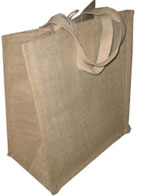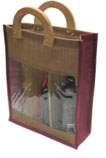
Jute (Corchorus capsularis & Corchorus olitorius) and Kenaf (Hibiscus cannabinus) are vegetable fibre plants second to cotton in importance. Corchorus capsularis is White Jute and Corchorus olitorius is referred to as Tossa Jute. The annual global production of jute and similar fibres is about 3 million tonnes.
Jute is a rainfed crop which is cultivated mainly in Bangladesh, India and Thailand which account for more than 90 percent of world production. Jute is very fast growing reaching a height of up to 4.5 meters in a period of 5 months. Jute fibre is a long, soft, shiny fibre that can be spun into coarse, strong threads. Jute fibres are extracted from plants through various stages such as retting, stripping, washing and drying. The colour of jute varies from light tan to brown and it can be easily bleached or dyed. Jute is a renewable energy source with a high production per hectare. Jute and jute products are biodegradable and environmentally friendly.
Jute fibre is used to produce hessian cloth, bags, carpet backing and geo-textiles. Jute cultivation and processing is labour-intensive and therefore provides a livelihood for many farmers and their families. Jute plants also clean the air by consuming large quantities of greenhouse causing CO2. One hectare of jute plants can consume about 15 tons of CO2 and release about 11 tons of oxygen during the jute growing season.
Growing, Cultivation & Harvesting of Jute
Jute requires temperatures of 24-38 degrees Celsius and a minimum rainfall of 1000mm for successful cultivation. Jute may be grown in sandy loams or clay loams and White jute prefers medium to high land and even tolerates water logging.
Raw jute is classified according to quality of jute and its application. According to the International Jute Study Group in India, the fine quality white raw jute is graded as W1, W2, W3, — to W8, as described below.
“W1/TD1: Very good strength and colour, very fine heavy bodied fibre, free from major and minor defects. Maximum root content: W1-10%, TD1-5%.
W2/TD2: Good strength and colour, fine heavy bodied fibre, free from major and minor defects. Maximum root content: W2-15%, TD2-10%.
W3/TD3: Fairly good colour and strength well separated medium bodied fibre, free from major and minor defects except a few specks. Maximum root content: W3-20%, TD3-15%.
W4/TD4: Fair, average strength and colour, well separated medium bodied fibre, free from major defects and substantially free from specks and loose sticks. Maximum root content: W4-26 % , TD4-20 % .
W5/TD5: Average strength and colour, fine from major defects. Maximum root content: W5-36%, TD5-26%.
W6/TD6: Average strength, free from centre root and dazed/over-retted fibre and reasonably free from entangled sticks. Maximum root content: W6-46%, TD6 – 35%.
W7/TD7: Weak mixed fibre with maximum root content :W7-57%. TD7-35%.
W8/TD8: Entangled or any other jute not suitable for any of the above grade but of commercial value.”
Jute plants take about 90 to 100 days to reach their harvesting height of 8 to 12 feet high. The harvested jute is tied into bundles and is left for 4 or 5 days until their leaves are removed. The bundles are then steeped in water in a process called “retting”, in order to loosen the fibres from the stem of the plants. This process takes about 3 weeks. The fibres are then washed and sun dried. Retting of jute plants is a vitally important process which has a significant influence on the quality of the extracted fibre.
Jute and Non Woven Polypropylene

Jute’s competitiveness with polypropylene, from which non woven green supermarket bags are manufactured, is related primarily to the relative biodegradability and environmental footprint of each product. Jute is a natural compostable plant fibre which contributes to the livelihood of many farmers in developing countries whereas polypropylene is a totally synthetic non-compostable plastic manufactured by the petrochemical industry.
The environmental advantages of jute are well known as has been noted by World Jute.Com in their article: “What are the advantages of jute bags in comparison of poly sacks ?

Burwood Council has pointed out that unlike polypropylene bags “hemp or hessian bags” are biodegradable and can be expected to last up to 10 years compared to 2-3 years for non woven polypropylene.
Not surprisingly, the Ipswich City Council in Queensland, Australia, has described jute bags as “the logical ‘next step’ for socially-concerned shoppers and retailers“:
“Jute bags are biodegradable alternatives to the green polypropylene bag. They are naturally recyclable and are the logical ‘next step’ for socially-concerned shoppers and retailers. The bag can be recycled by composting them or using as mulch in the garden. Jute is a long, soft shiny plant fibre that can spun into coarse, strong threads. Jute is one of the most abundant natural fibres and is second only to cotton in the amount produced and variety of uses.”
Widespread support by the environmentally aware for jute bags to replace synthetic non woven bags is hardly surprising given the scientific facts. According to the United Nations in their report entitled Jute and Hard Fibres: Overview of Major Current Issues, jute has the following advantages as compared to non woven polypropylene.
1. Production of polypropylene fibre requires 10 to 20 times more energy than jute fibre.
2. Production of 1 ton of polypropylene produces 3.7-7.5 tons of CO2 whereas jute production has a negative impact on CO2 production.
3. Jute is a totally renewable resource whereas polypropylene is derived from non renewable resources.
4. Jute is biodegradable and compostable whereas polypropylene is not biodegradable and causes environmental accumualtion of plastic and releases cancer causing compounds.
In regard to the environmental advantages of jute the United Nations summarises thus:
“Jute and hard fibres (JHF) show a distinct competitive edge over synthetics in a number of environment-related areas. First, energy consumption in the production and transformation of synthetic raw materials is about 10 times higher than that needed for natural fibres. Secondly, while synthetics release considerable amounts of CO2 during their life-cycle, natural fibres absorb harmful gases rather than release them. Thirdly, JHF represent quickly (on a year’s basis) renewable resources, whereas production of polypropylene is based on the use of non-renewable fossil resources. Fourthly, the major advantage of JHF, however, and the most appealing to consumers’ concerns, is related to the waste-disposal stage of the product’s life. Natural fibres are fully biodegradable while, broadly speaking, synthetic materials are not……Furthermore, when disposed of, synthetics may have a seriously damaging impact on the environment, due to the release of a number of toxic substances. On balance, natural fibres are more environmentally sound and thus, less costly to society, than competing synthetic materials.”
While the Food and Agriculture Organisation of the UN also (FAO) acknowledges that biodegradability is a significant advantage of jute as compared to polypropylene, they point out that the main advantage of polypropylene is its comparatively low cost as compared to jute, non woven polypropylene supermarket bags being typically 50-75% cheaper than equivalent jute bags, part of this increased cost being due to the much higher freight costs of jute.
According to the FAO:
“Jute’s competitiveness relative to polypropylene is determined by both price and non-price factors. Increasing returns to scale in the petrochemical industry, as well as its vertically-integrated structure that allows a flexible allocation of cost components along processing stages for different outputs, contribute towards decreasing unit costs. This therefore results in polypropylene polymer and the related synthetic products being price competitive with their jute counterparts. Non-price factors include technical characteristics such as the heavy weight and the related unsuitability of jute sacks for automatic filling systems as compared to polypropylene sacks; the superior breathability of jute sacks vis-à-vis the water-resistant qualities of synthetic sacks; and the biodegradability of jute.”
The International Trade Centre, in their recent report, A Road Map For Jute, has also emphasised the environmental advantages of jute as compared to synthetic competing fibres:
“In environmental terms jute wins the competition hands down. Provided jute, a renewable resource with a very low environmental footprint it is to be greatly preferred to using plastic packaging, which for the next few decades will inevitably be based on mineral oil, a non-renewable resource and one which costs India valuable foreign exchange. In social terms, the arguments are also almost all in jute’s favour. We can note the part time employment jute gives to about 4 million farmers in India and to the several hundred thousand employees in the mills and also needed for raw jute transport and jute goods distribution. As we have noted in the case of agriculture these may be arduous and poorly paid jobs but they are available to people at the bottom of the income scale and for that reason alone these jobs are all the more important for social reasons…….”The‘green’ credentials of jute bags and fabrics are excellent. There is rapidly growing world wide awareness of environmental problems and of the need for sustainable development. The use of plastics in packaging and in man-made fibre textiles, are increasingly seen as part of the problem and not as part of the solution.”
From an environmental perspective the advantages of jute as compared to polypropylene are abundantly clear there being no environmental comparison between natural agricultural crops and synthetic plastics produced by the petrochemical industry.
When it comes to financial cost however, the advantages of polypropylene are clear, though the costs to the environment may not yet be so clear. For these reasons, those corporations and organisations who choose to utilise more expensive jute products are clearly leading the way and putting the environment first.
Check our range of natural fibre jute bags.




